
13.07.2015
What would happen if an earthquake would bring down the Soumaya Museum and the Jumex Museum?
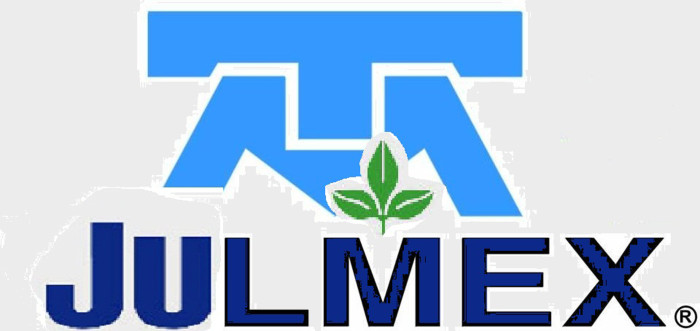
Two Hundred Times Better than 5G
Another variation on the Julmex Collection
Introduction:
The driver looks into the rear-view mirror as he speaks, seeking out my eyes. “We Jehovah’s Witnesses have guaranteed entry into Heaven.” At the same time, my ex-girlfriend’s voice wafts in through the taxi window, as if her breath possessed the air particles, as if her verbal gust was dragged to my eardrum to massage my earwax stalactites.
The cabbie, a small man, like a tall nine-year-old, warns me of the end of the world, the Day of Final Judgment as I, Daniel, contemplate that I do not know how to get to Plaza Carso. It’s raining, or it had rained. He goes on preaching, in detail, about the Archfiend’s customs and ways. I pay the requisite attention, until the inner murmur of my mother’s voice distracts me: “I’m going to shove an ice cube up your ass, you son of a bitch.” I pay with a 200 peso note and Jehovah (that’s what I named the driver), exercised, jumps out of the cab because he has no change. It’s the perfect excuse to open other taxis’ doors, ask for change, recruit witnesses, believe in the Gospel and hand me what’s left over. Thanks. “I can see your black, burnt-up pork rind face crackling in Hell,” either Jehovah, or my ex, observes.
The Soumaya Museum’s grassy skirts are clipped level, like a failed rapper’s haircut. It’s Mexico’s biggest quinceañera cake: modern, no icing, covered in mirrors (apt for spec-ulation), each one slices off an optical illusion. Clinically approved. On the contrary, the Jumex Museum rises, soberly, like a repressed Tetrapak, crowned by a handsaw’s teeth, a birdbath for helicopters. The buildings’ capricious shapes remind me of bottles that could hold perfume, or fancy drinks or internet. I end up seeing both museums’ exhibitions through the one at the Julmex Collection.
Last year my friend the English artist Jeremy Hutchison had an excessive post-apocalyptic vision that seized my imagination: “What would happen if an earthquake took down the Soumaya and the Jumex Museums?” he wondered before a group of art professionals gathered at SOMA. Hutchison was articulating the question from an ethical position: solidarity in light of a social emergency. What would be culture’s — specifically the culture industry’s — use value in light of a misfortune of that magnitude? What ought we to do in such a case?
As a response I discarded an ethical fiction that might represent the moments of solidarity that emerge from catastrophe. I mostly thought of an aesthetic scenario. That was why I tried to speculate with what was already here, what we have: things, materiality, artworks, merchandise, bodies, and potential pathologies. Suppose that the Telmex and Jumex corporate collections were combined, with their respective objêts d’art and merchandise: what other collection would be possible? The Julmex Collection emerges as just one more among possible responses to the question Jeremy threw out.
You can read the first one here.
The second is the transcription of a letter I have at home that I’ve copied below in its entirety.
The third consists of two press releases and a series of images from Julmex Collection shows soon to appear in Terremoto.
***
Two Hundred Times Better than 5G
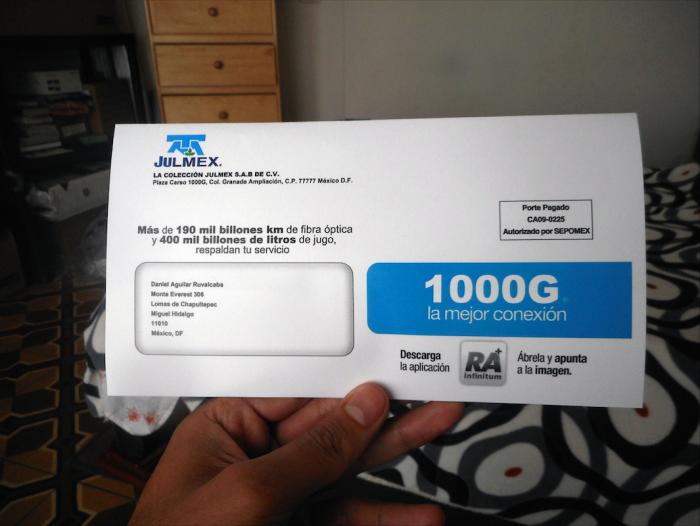
All I have to say is that one of my grandfathers was the Teléfonos de México magnate for people to recognize and pay attention to me. It’s cold and the expiration date on the fresh milk I’m drinking is September 2035.
By now you’re surely wondering how can that message be sent from my future? A future that quite probably by this time is already your present. The explanation is very simple. If Carlos Slim was once the richest men on the planet, and time is money, then I have time to spare because grandpa handed down his entire fortune to my father and me, in a trust, and my father transferred it to me before his accidental death.
A constant movement in my wrist as I swipe credit cards, sign checks or move money was the training my hands needed to grow so rapid and light that one day they could dig a tunnel to the past or the future. I learned to touch, write, compose, and dispose of time fragments. “Time is the best author—it always comes up with a perfect ending,” Charlie Chaplin said, and I tattooed that onto my right wrist, beneath my watch. The faster I moved money, and the greater the amount, the simpler it was to break the fine membrane of the linear space-time barrier that separated me from the infinite. I’ll let you in on it: one day when I was totally fucked up on coke I swiped a card so quickly I ended up parting the Red Sea, hundreds of years ago… So coincidentally I saved Moses.
Additionally, I am writing this as fast as I hand out money — digging a hole in reverse.
My inheritance consisted not only of millions of dollars but also included abundant telephone connections in delicate fiber optics (my father used to joke they were to ‘lighten up the Mexicans’ heavy gaze’), modems with centuries of broadband, Sanborns restaurants with centuries of americano-style coffee, the Vips restaurants, of course, and a bunch of stuff you don’t know today and that tomorrow will all be mine — like the Post-Internet of Sugared Things originally autonomous network. Other popular items — like kidney stones, anthills, and tectonic faults — will be mine, too.
But before going any further, allow me to comment with regard to three important dates:
1985. During the 1985 Mexico City earthquake — that unforgettable morning when the city shook so much it tumbled down — my father Carlos Slim S olympically penetrated my mother, María Helena Corruto de V, in order to reproduce. I was not conceived at that time. That said, the natural disaster affected how my father introduced his penis into my mother, since the only way they could come to orgasm as a couple was during earthquakes. Bodies and buildings alike collapsed at the precise instant their viscous tectonic plates rubbed and when they were through their broken glances, blanketed in smoke, survived.
Aiming to maintain an active sex life, my parents got into a perverse real-estate niche: tectonic faults purchase and privatization.
1994. I am literally the “December mistake,” the 1994 peso devaluation crisis. My mother got pregnant on the very day in 1994 when most poor Mexican ingenuously believed they would become millionaires.
2015. By way of a before-the-fact wedding anniversary celebration (thirty years after the ’85 earthquake) and mid-life crisis, my parents rocked Plasa Carso from the Soumaya Museum bathroom and thus the famed Julmex Collection was born.
Carlos and María Helena had uncontrollable, filthy imaginations. My mother got really wet when she saw the pedestal where the very ESPN body of Rodin’s Thinker stood. When she imagined separating it from the floor and seeing how its foundations defied gravity to orchestrate the din of the world’s creation, her crotch turned into a waterfall. My father, on the other hand, noting a female guard’s dried-out hair resembled John Lennon’s deathbed locks, quickly got as hard as a Viagra® diamond. So it was that they called their advisors from the Soumaya bathroom sinks and murmured 1000Gs, but just the tip.
Multi-million-dollar investments were sunk into the study of tectonic faults to know how to reproduce, in a controlled fashion, the conditions that cause earthquakes. This was always a whim that research kept secret, exclusively for the sexual recreation of perverse investors. No one involved believed you could make a profit from it. The only thing it would bring would be irreversible damage to the earth and a few minutes of unforgettable pleasure for the couple involved. Nevertheless, as the years passed, certain investigations turned up something incredible that would be the twenty-first century’s greatest telecommunications advance: friction on the part of tectonic plates could generate an absolute, organic, inexhaustible, and nutritious internet. 1000G — that’s what my father called it, because it was 200 times better than 5Gs. 1000G is an air-space and air-time excavator that lets me send you this message, for example.
The technology they developed allowed for controlling an earthquake’s radius with GPS. Plaza Carso was one of the first places they equipped with this seismic set-up; my parents fucked all over the place. It was their libidinal amusement park.
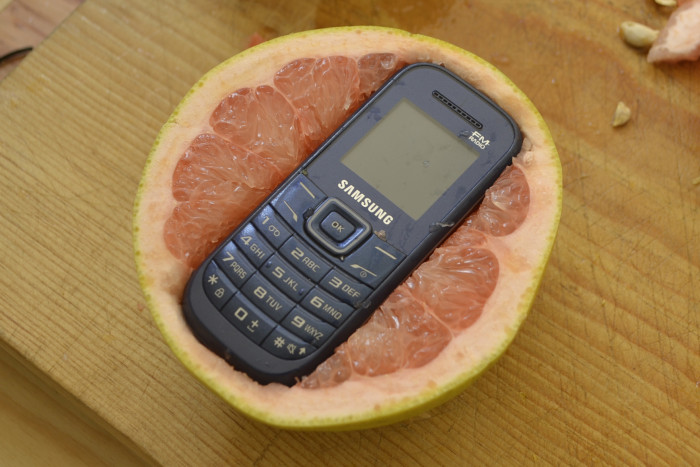
Let us return to the Soumaya and 2015. After mentioning the secret code to the operators, Carlos and María Helena entered a bathroom stall. As the powder room speakers emitted an instrumental version of Coldplay’s “Speed of Sound,” everything started to quiver as if the building had come down with Parkinson’s disease, as if the dopamine in its walls had been brusquely extracted. It is not known if it was vengeance on the part of some radical or some grave error, but we do know for sure that it was just the tip, nothing more, because the museum fell through, and at Plaza Carso, too. The earth had never borne so much pleasure as gushed from Carlos and María Helena’s bodies; they were temporarily suspended, like dust clouds, to later condense and rain down as rubble.
Trees busting beams, the knees of Mexicans — with a large European genetic load — sausaged into water and glass; shiny mud covers the remnants of the pavement that now swallows the light the open white cube let escape from its cracked vertices. What remains of my father’s organism lies connected to meters of fiber optic cable, themselves affixed to what looked like a Calder sculpture that lots of people have confused with the hood of a Chevy; at the extreme opposite end of the plaza his eye sockets show, covered by colonial-era coins bearing indiscreet Jacobin symbols.
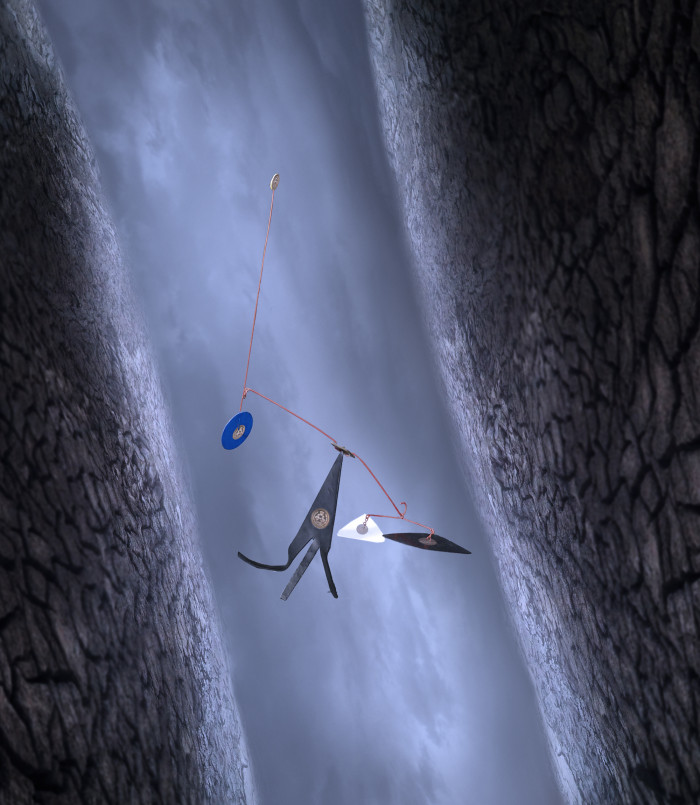
I was orphaned. My grandfather died a week later in a tragic car accident that left only his double chin intact, like a flan for a hundred or more party guests. The good thing was that Eugenio López showed up right then, extended his hand to me, and within a few days had become my father and spiritual guide. The Jumex Museum had fallen to pieces, just like the Soumaya and there was no way to reclaim the land because the tectonic plates never stopped rocking. During my dead relatives’ novenas I proposed creating the Julmex Collection to Eugenio. He accepted with delight. I should clarify that back then I had no knowledge of the 1000G and Post-Internet of Sugared Things tech advances that would emerge a month later and that would lead me to possess much more money than all my ancestors and descendants put together.
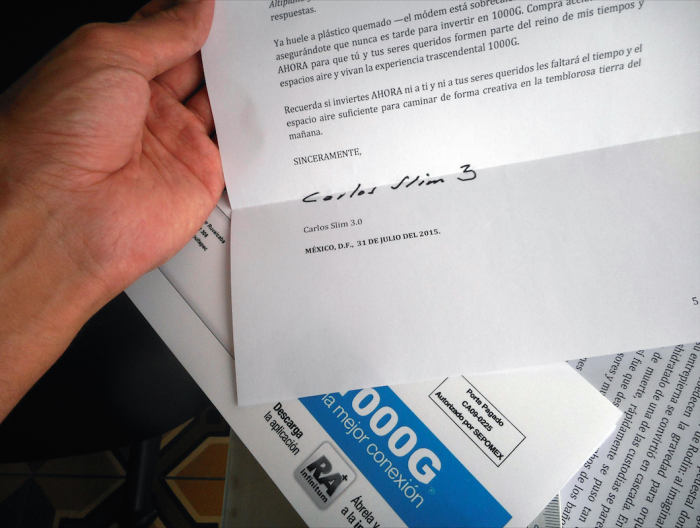
It will sound like something out of a story, but Eugenio López died mysteriously, roasted in a tanning bed, one month following our deal. But there is a good side to it, since, as regards the Julmex Collection, I have everything classified—everything is in order to honor Eugenio’s as well as my family’s memory.
Despite what certain reckless individuals insist — motivated by their leader, that indefatigable State destabilizer, the supposed English artist Jeremy Hutchison — that rubble is mine! It belongs to me! My grandfather and my godfather Eugenio (may God rest his soul) gave it to me! Teams of specialists —stockbrokers, geologists, anarchists, engineers, programmers, photographers, museographers, historians, art curators, and others like them — are working twenty-four hours a day, seven days a week, three hundred sixty-five days a year to classify, measure, and document the latest reorganizations of what moves in now extinct Plaza Carso, where there are fabulous aftershocks by the second. Naturally we opened a new, world-class exhibition in five minutes, on average, like a Cup-o’-Noodles soup. The permanent collection is always being updated with a given element’s addition or discarding. Yes, agitated collecting is my passion.
The earth has not stopped moving since then (4), and to be frank, I sometimes don’t know if I’m still in Mexico anymore. However, I quickly recognize when I pass through China because of the way the waves act. What I definitely like best about Africa’s continental skirts are their legs. GPS precision is short-lived due to the tectonic plates’ perpetual movement, which prevents the existence of valid calculations for more than five minutes. In contrast, 1000G enjoys air-time- and -space precision. It’s infallible.
If 1000G has been good for anything, it has been to awaken human creativity and to grow together in my air-time and -space. It is systematic and it has been proven that when hope is exhausted, when crisis ensues, the masses who make up people x get organized and motivated, and rise up to change the course of the system that led to collapse — something changes. Let’s not get into theory or hard concepts; let’s get down to the immediate, to the physical. Clearly the emancipation that happens after a period of oppression makes people move differently. Earth is a sensitive territory; like the pedal on an electric guitar, you have to know how to push down on it for it to make unthinkable sounds. 1000G potentiates and captures those registers and connects us to everyone two hundred times more.
Have you ever wondered what it would feel like to be touched by my grandfather, Carlos Slim’s, index finger? What it would feel to be El Chapo Guzmán’s iPod — before he escaped from El Antiplano — and to feel that national hero’s arid fingers? 1000G gives you the answers.
It’s starting to smell like burnt plastic — the modem is overheating — s o I’ll say goodbye while assuring you it’s never too late to invest in 1000G. Buy Telmex stock NOW — so you and your loved ones can be part of the realm of my air-time and -space and live the transcendental 1000G experience.
Remember, if you invest NOW, neither you nor your loved ones will ever lack for enough air-time and -space to walk creatively on tomorrow’s trembling earth.
Sincerely,
Carlos Slim 3.0
Notes:
(1) The Old Testament’s Exodus contains a detailed account of events.
(2) The Post-internet of Sugared Things (PIoST) is a concept that refers to sugared things’ digital interconnection after the internet. Additionally, it is often referred to as the “post-internet of all carbohydrates” or the “post-internet in carbohydrates.” What’s more, the post-internet of sugared things is the point in time when more “sugars or carbohydrates” than people would connect to the internet.
It is no eventuality that the PIoST—the first autonomous and public interconnection network of what can be sensed, that accesses objects’ semiotic carbohydrates to understand and store data that calculate and track the energy of political tierces—was generated after the fall and collision of the two greatest and most distinct material expressions of semiotic capitalism in Mexico.
The PIoST asks itself, “How is it that the dis-sensual is distributed and redistributed among things and people?” For example, if all the carbohydrates of the political, the ethical and the social were connected to the internet and equipped with identifying devices, no energies (sensibilities)—save stock or expired energies—would in theory exist; we would know the exact location of the entire world’s sensibilities as well as how they are burned and distributed: the misplacement of what can be sensed would be a thing of the past and we would know if it were on or off at all times.
(3) The Julmex Collection is a contemporary, modern and classical art collection in the soils and sub-soils of Plaza Carso that principally gathers the artworks of the now inexistent and formerly renowned Soumaya and Jumex corporate collections, property of businessmen Carlos Slim (Grupo Carso) and Eugenio López (Grupo Jumex), respectively.
(4) Before 1000G was made available to the public it was rumored among new age types that the planet contracted Parkinson’s disease. Before the Post-Internet of Sugared Things, it was said to be diabetes.
Comments
There are no coments available.